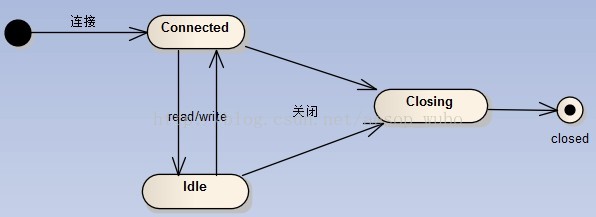mina2中的session
简介
session类图

Mina每建立一个连接同时会创建一个session对象,用于保存这次读写需要用到的所有信息。从抽象类AbstractIoSession中可以看出session具有如下功能:
1、从attributes成员可以看出session可以存放用户关心的键值对
2、注意到WriteRequestQueue,这是一个写请求队列,processor中调用flush或者flushNow方法时会将用户写入的数据包装成一个writeRequest对象,并加入这个队列中。
3、提供了大量的统计功能,比如接收到了多少消息、最后读取时间等
在代码中一般是这样使用session的
// 创建服务器监听 IoAcceptor acceptor = new NioSocketAcceptor(); // 设置buffer的长度 acceptor.getSessionConfig().setReadBufferSize(2048); // 设置连接超时时间 acceptor.getSessionConfig().setIdleTime(IdleStatus.BOTH_IDLE, 10);
session做为一个连接的具体对象,缓存当前连接用户的一些信息。
创建好acceptor或者connector之后,通过IoSessionConfig对session对行配置。
用得最多的是通过session写入数据,这是调用了IoSession的write方法
WriteFuture write(Object message);
WriteFuture write(Object message, SocketAddress destination);
下面着重分析创建过程以及session的状态
创建与初始化
每建立一个连接,就会创建一个session,IoAcceptor的accept方法的返回值正是一个session。见NioSocketAcceptor.accept(IoProcessor<NioSession> processor, ServerSocketChannel handle)方法:
protected NioSession accept(IoProcessor<NioSession> processor, ServerSocketChannel handle) throws Exception { SelectionKey key = handle.keyFor(selector); if ((key == null) || (!key.isValid()) || (!key.isAcceptable())) { return null; } // accept the connection from the client SocketChannel ch = handle.accept(); if (ch == null) { return null; } return new NioSocketSession(this, processor, ch); }
由以上代码可知,session包含了对众多对象的引用,比如processor,socketChannel,SelectionKey,IoFilter等。
session在创建好后,紧接着就会对其进行初始化。AbstractIoService.initSession(IoSession session, IoFuture future, IoSessionInitializer sessionInitializer)方法如下:
protected final void initSession(IoSession session, IoFuture future, IoSessionInitializer sessionInitializer) { // Update lastIoTime if needed. if (stats.getLastReadTime() == 0) { stats.setLastReadTime(getActivationTime()); } if (stats.getLastWriteTime() == 0) { stats.setLastWriteTime(getActivationTime()); } // Every property but attributeMap should be set now. // Now initialize the attributeMap. The reason why we initialize // the attributeMap at last is to make sure all session properties // such as remoteAddress are provided to IoSessionDataStructureFactory. try { ((AbstractIoSession) session).setAttributeMap(session.getService().getSessionDataStructureFactory() .getAttributeMap(session)); } catch (IoSessionInitializationException e) { throw e; } catch (Exception e) { throw new IoSessionInitializationException("Failed to initialize an attributeMap.", e); } try { ((AbstractIoSession) session).setWriteRequestQueue(session.getService().getSessionDataStructureFactory() .getWriteRequestQueue(session)); } catch (IoSessionInitializationException e) { throw e; } catch (Exception e) { throw new IoSessionInitializationException("Failed to initialize a writeRequestQueue.", e); } if ((future != null) && (future instanceof ConnectFuture)) { // DefaultIoFilterChain will notify the future. (We support ConnectFuture only for now). session.setAttribute(DefaultIoFilterChain.SESSION_CREATED_FUTURE, future); } if (sessionInitializer != null) { sessionInitializer.initializeSession(session, future); } finishSessionInitialization0(session, future); }
设置上次读写时间,初始化属性map和写请求队列等。
session被初始化好之后会加入到processor中,processor中有一个队列专门存放session:
例如:AbstractPollingIoProcessor.java中有:
private final Queue<S> newSessions = new ConcurrentLinkedQueue<S>(); /** A queue used to store the sessions to be removed */ private final Queue<S> removingSessions = new ConcurrentLinkedQueue<S>(); /** A queue used to store the sessions to be flushed */ private final Queue<S> flushingSessions = new ConcurrentLinkedQueue<S>(); /** * A queue used to store the sessions which have a trafficControl to be * updated */ private final Queue<S> trafficControllingSessions = new ConcurrentLinkedQueue<S>(); /** The processor thread : it handles the incoming messages */ private final AtomicReference<Processor> processorRef = new AtomicReference<Processor>();
加入队列之后,processor就会从队列中取出session,以下是processor的run方法关键代码:
-
private class Processor implements Runnable { public void run() { for (;;) { long t0 = System.currentTimeMillis(); int selected = select(SELECT_TIMEOUT); long t1 = System.currentTimeMillis(); long delta = (t1 - t0); if ((selected == 0) && !wakeupCalled.get() && (delta < 100)) { if (isBrokenConnection()) { wakeupCalled.getAndSet(false); continue; } else { registerNewSelector(); } wakeupCalled.getAndSet(false); continue; } nSessions += handleNewSessions(); updateTrafficMask(); if (selected > 0) { process(); } nSessions -= removeSessions(); } } }
2、从newSessions队列中取出这些session,并将其负责的通道注册到selector上
3、处理准备就绪的session
AbstractPollingIoProcessor.java
private void process(S session) { // Process Reads if (isReadable(session) && !session.isReadSuspended()) { read(session); } // Process writes if (isWritable(session) && !session.isWriteSuspended()) { // add the session to the queue, if it's not already there if (session.setScheduledForFlush(true)) { flushingSessions.add(session); } } }
总结一下创建与初始化过程:连接到来创建一个session,初始化好之后加入到processor负责的一个队列中。processor线程会把队列中的session对应的通道都注册到它自己的selector上,然后这个selector轮询这些通道是否准备就绪,一旦准备就绪就调用对应方法进行处理(read or flushNow)。
 IoFilter与IoHandler就是在这些状态上面加以干预,下面重点看一下IDLE状态,它分三种:
IoFilter与IoHandler就是在这些状态上面加以干预,下面重点看一下IDLE状态,它分三种:
状态
Mina中的session具有状态,且状态之间是可以相互转化的
Connected:session被创建时处于这种状态
Idle:没有请求可以处理(可配置)
Closing:正处于关闭状态(可能正在做一些清理工作)
Closed:关闭状态
下图是这几种状态之间的转化图:
Idle for read:在规定时间内没有数据可读
Idle for write:在规定时间内没有数据可写
Idle for both:在规定时间内没有数据可读和可写
这三种状态分别对应IdleStatus类的三个常量:READER_IDLE、WRITER_IDLE、BOTH_IDLE
前面session的用法中有如下设置:
acceptor.getSessionConfig().setIdleTime(IdleStatus.BOTH_IDLE, 10);
acceptor的run方法中调用了notifyIdleSessions
-
private static void notifyIdleSession0(IoSession session, long currentTime, long idleTime, IdleStatus status, long lastIoTime) { if ((idleTime > 0) && (lastIoTime != 0) && (currentTime - lastIoTime >= idleTime)) { session.getFilterChain().fireSessionIdle(status); } }
public void fireSessionIdle(IdleStatus status) { session.increaseIdleCount(status, System.currentTimeMillis()); Entry head = this.head; callNextSessionIdle(head, session, status); }




